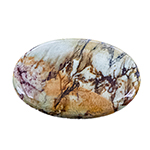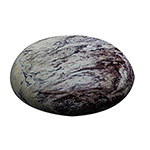Alunite
Quite common mineral of the sulphate class.

Extraordinarily patterned alunite from Amstall, Lower Austria
Origin of name: from Latin alumen = Alum
First described in 1797 by French chemist, mineralogist, geologist and paleontologist Jean-Claude Delamétherie as aluminilit, which was shortened to alunite in 1824 by François Sulpice Beudant, another French mineralogist and geologist.
Synonyms and trade names: alumspar, alumstone, calafatite, loewigite, newtonite and several more
Locations: 2024 more than 1000 localities an all continents including Antarctica were known. Most important deposits are in Italy (Solfatara near Naples, La Tolfa near Rome), Bereghszasz (Hungary), Goldfield and Sulphur/Nevada (USA), Bulla Dela and Lake Campion (Australia).

Alunite from Nevada, USA
Handling: due to the very low hardness and perfect cleavage alunite is not suited well for jewellery use.
Worth knowing: alunite is used for the production of alum, an important base material for the dye, pharmaceutical, cosmetics, leather and paper industries. The La Tolfa deposits are known to have been worked since the 15th century, at that time under control of the Medici popes.
Alunite is strongly pyro- and piezoelectric.
 Deutsch
Deutsch